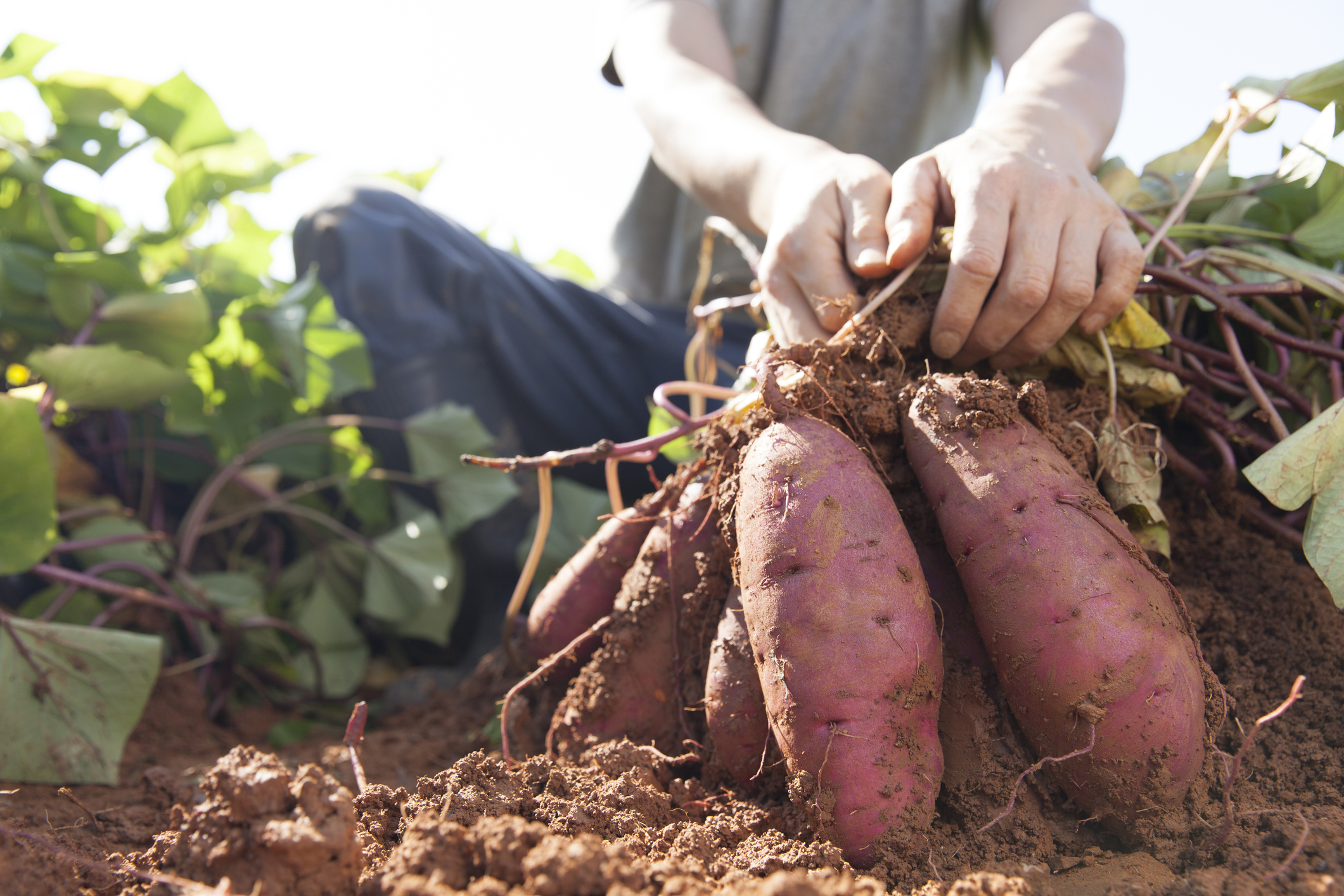By Libby Rens, PhD
Well-drained, sandy-loam soils are great for promoting sweet potato quality and yield but can be a challenge when it comes to maintaining adequate soil fertility. Sweet potato is a high nutrient user, but the well-drained, sandy-loam, slightly acidic soils best for sweet potato marketability and skin quality also make a soil prone to rapid infiltration of water and solutes. As with most crops, soils with high native fertility are most desirable; however, this is not always the case in areas well suited for sweet potato.
“Soils with lower native fertility can have excellent production if a well-planned fertilizer program is implemented.” UGA Commercial Vegetable Production
Soil pH
Sweet potato thrives when pH ranges from 5.8 to 6.0. Even at this moderately-acidic range, key soil  nutrients are limited and will need additional supplementation.
nutrients are limited and will need additional supplementation.
Cation nutrients like potassium and magnesium will be displaced in the soil by an abundance of H+ ions in acidic soils, making these nutrients more susceptible to leaching and reduced availability. Magnesium, in particular, is sensitive to low pH, with availability severely declining below a pH of 6.5.
Create a Crop Nutrition Plan

A pre-season soil test to base fertility decisions is the first step in creating a well-balanced plan. This can be followed up with tissue tests from the most recently mature leaf to make adjustments mid-season. Maximum nutrient uptake and deficiency symptoms are most prominent during bulking, but this is often too late to make mid-season corrections. Consider optimizing the rate, timing, placement, and source of these key nutrients.
- Rate – Apply sufficient nutrients throughout the season to overcome losses.
- Timing – applying as close to planting, or consider splitting applications, with a portion going on as a top dress or layby 3 to 4 weeks after planting.
- Placement – banding will increase the efficiency of application as compared to broadcast.
- Source – When you are experiencing a nutrient deficiency, it is important to apply an immediately available nutrient source.
Nutrients for Sweet Potato in Intrepid Trio®
Incorporating Intrepid Trio® as part of a custom blend for sweet potatoes provides balanced crop nutrition for potassium, magnesium, and sulfur.
Potassium
Sweet potatoes require a high level of potassium fertilization to promote maximum yield, needing about 3x more potassium than nitrogen! Potassium is key for drought resistance, water regulation, and cell elongation. Sweet potato harvest removes 150-160 lbs of potassium per acre, but 250-280 lbs per acre is required to support plant growth and production throughout the season (UGA, NCSU). Intrepid Trio® provides readily available low-chloride potassium ideal for sweet potato nutrition.

Magnesium
The majority of the humid southeast is deficient in soil magnesium. The map to the right displays the  extremely low levels of Mg in the root zone of the southeast US. In this region, up to 50 lbs of Mg lost to leaching and erosion each year. Sweet potato growers are aware of the need for magnesium fertilization, but most are only applying 40% of what is recommended to meet crop demand. 25 lbs of magnesium per acre are recommended when your soil test measures low (UGA). This can be accomplished by applying 225 lbs of Intrepid Trio®.
extremely low levels of Mg in the root zone of the southeast US. In this region, up to 50 lbs of Mg lost to leaching and erosion each year. Sweet potato growers are aware of the need for magnesium fertilization, but most are only applying 40% of what is recommended to meet crop demand. 25 lbs of magnesium per acre are recommended when your soil test measures low (UGA). This can be accomplished by applying 225 lbs of Intrepid Trio®.
Sulfur
Sulfur nutrition is essential for protein production, increasing nitrogen efficiency, and maximizing your nitrogen investment. Sulfur is not mobile in the plant, so rapidly growing tissue and tuberous roots are most susceptible to deficiency. A 500 bu/ac sweet potato crop removes around 10 lbs of sulfur per acre. Sulfate is the only plant available form of sulfur and is the source found in Intrepid Trio®. Sulfate needs to be regularly supplemented as it is highly susceptible to leaching in light soils.
Intrepid Trio®
Intrepid Trio® is 100% natural langbeinite, a unique mineral with three essential nutrients in every granule providing a long-lasting, readily available source of low-chloride potassium (22% K2O), 11% magnesium and 22% sulfur at a ratio ideal for sweet potatoes grown in sandy, high rainfall, low CEC soils. Intrepid Trio® is also available in OMRI listed grades approved for organic farming.

